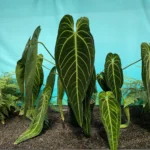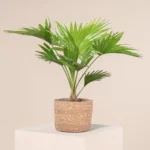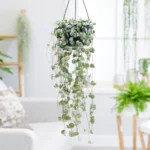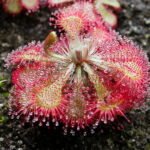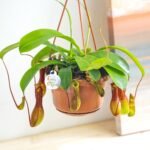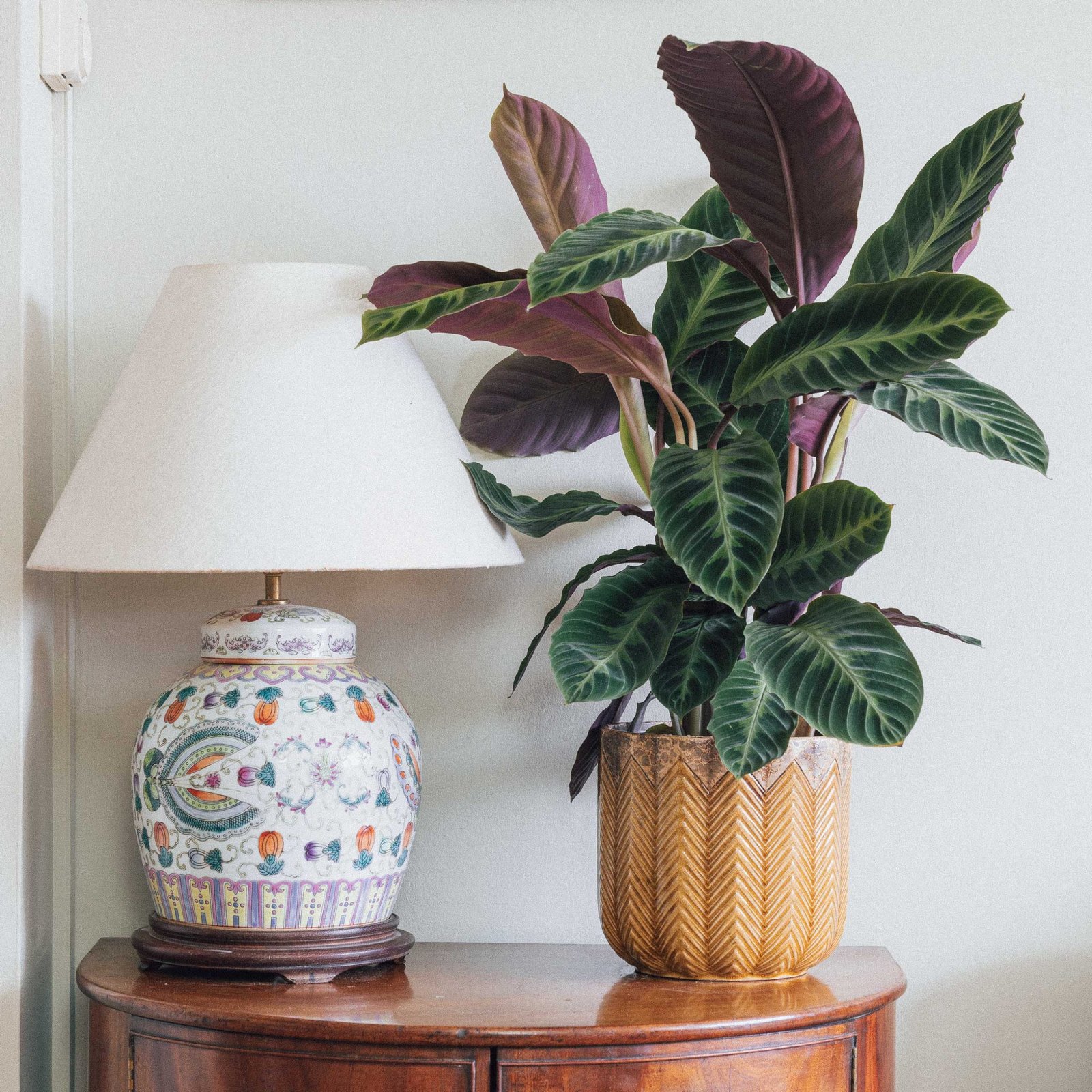Categories: Houseplants, Foliage Plants, Shade-Loving Plants, Tropical Plants, Seasonal Plants
Caladium, Angel Wings, elephant ear plant, colorful foliage, shade plants, tropical houseplants
Caladium: Mastering the Art of Growing Heart-Shaped Splendor

Introduction
Welcome to the vibrant world of Caladiums, nature’s living canvas! Known for their stunning heart-shaped leaves splashed with an array of colors, Caladiums (Caladium bicolor) are tropical perennials that bring a touch of exotic beauty to any space. Often called “Angel Wings” or “Elephant Ears,” these plants are prized for their ability to add drama and color to shaded areas both indoors and out.
History and Origin
Caladiums are native to the tropical rainforests of South and Central America, primarily Brazil and the Amazon basin. They were first discovered by European explorers in the 18th century and quickly became popular in Victorian-era gardens for their showy foliage.
The genus Caladium belongs to the Araceae family, which includes other popular houseplants like Philodendrons and Monsteras. The name “Caladium” is derived from the Malay word “keladi,” meaning a plant with edible roots.

Plant Description
Caladiums are grown primarily for their foliage, which emerges from tubers. The leaves are typically heart-shaped or arrowhead-shaped and can reach sizes of 6 to 12 inches long. What makes Caladiums truly spectacular is their color palette:
- Shades of green, white, pink, and red
- Patterns including spots, streaks, veins, and borders
- Some varieties feature nearly solid colors, while others showcase intricate designs
While Caladiums can produce flowers, they’re usually small and insignificant compared to the dramatic foliage. The plant’s growth habit is clumping, with leaves arising directly from the tuber on slender stems.
Popular Varieties
- ‘White Christmas’: Large white leaves with green veins
- ‘Red Flash’: Dark green leaves with red center and pink spots
- ‘Florida Sweetheart’: Pink leaves with green edges
- ‘Candidum’: White leaves with green veins, classic variety
- ‘Miss Muffet’: Lime green leaves speckled with pink

Plant Care
Light Requirements
Caladiums thrive in bright, indirect light or partial shade. They can tolerate some morning sun but should be protected from harsh afternoon rays. Indoors, place them near a north or east-facing window.
Watering Needs
Keep the soil consistently moist but not waterlogged. Water when the top inch of soil feels dry. Reduce watering in fall as the plant enters dormancy.
Humidity
As tropical plants, Caladiums love humidity. Aim for levels above 50%. Use a pebble tray, humidifier, or regular misting to increase moisture around the plant.
Temperature
Optimal temperature range is 60-85°F (15-29°C). Protect from cold drafts and temperatures below 60°F (15°C).
Soil Requirements
Use a well-draining, rich potting mix. A blend of peat moss, perlite, and regular potting soil works well.
Fertilizer
Feed monthly during the growing season with a balanced, water-soluble fertilizer diluted to half strength.

Pruning
Remove any yellowing or damaged leaves at the base of the stem. Pruning isn’t necessary for shape but helps maintain the plant’s appearance and health.
Propagation
Caladiums are typically propagated by dividing tubers:
- In spring, gently dig up the tuber.
- Cut the tuber into sections, ensuring each has at least one eye (growth point).
- Allow cuts to dry for a day before planting in fresh potting mix.
- Keep soil moist and warm until new growth appears.

Potting and Repotting
Repot Caladiums annually in spring when new growth begins:
- Choose a pot 1-2 inches larger in diameter with drainage holes.
- Use fresh potting mix.
- Plant tubers about 2 inches deep, with the growing tips facing up.
- Water thoroughly after repotting.
Pests and Diseases
Common Pests
- Spider mites
- Aphids
- Mealybugs
Treat infestations with insecticidal soap or neem oil.
Diseases
- Root rot (from overwatering)
- Fungal leaf spots
Prevent by avoiding overwatering and maintaining good air circulation.
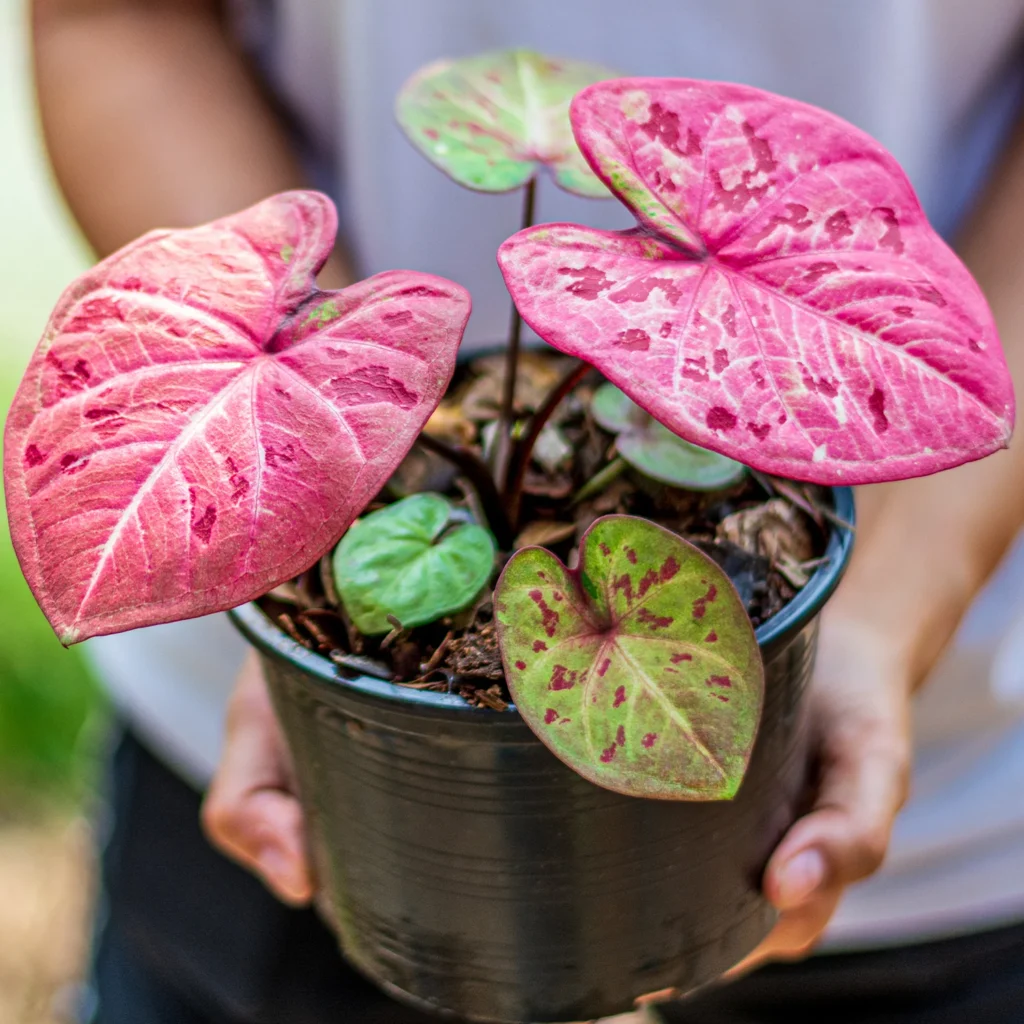
Seasonal Care
Caladiums have a natural dormancy period:
- In fall, reduce watering as leaves begin to yellow.
- Once foliage dies back, cut stems to soil level.
- Store tubers in a cool, dry place (55-60°F / 13-15°C) for winter.
- In spring, replant tubers and resume regular care.
Common Problems
- Pale leaves: Usually indicates too much light. Move to a shadier spot.
- Leaf edges browning: Often due to low humidity or inconsistent watering.
- Leggy growth: Insufficient light. Increase brightness without exposing to direct sun.
- Leaves drooping: Usually a sign of underwatering or low humidity.

FAQs
Are Caladiums toxic?
Yes, all parts of Caladiums are toxic if ingested. Keep away from pets and children.
Can Caladiums be grown outdoors?
Yes, they make excellent shade garden plants in USDA zones 9-11. In cooler areas, they’re often grown as annuals or brought indoors for winter.
Why are my Caladium’s colors fading?
Color fading is often due to too much light or the natural aging process of leaves.
How long do Caladium plants live?
With proper care and winter storage, Caladium tubers can last for many years, producing new foliage each growing season.
Tips for Success
- Rotate the plant regularly for even growth.
- Clean leaves gently with a damp cloth to remove dust and maintain their vibrant colors.
- In very hot climates, provide afternoon shade to prevent leaf scorch.
- For fuller plants, plant multiple tubers in one pot.
- Experiment with different varieties to create stunning color combinations.
Quick Facts
| Attribute | Detail |
|---|---|
| Scientific Name | Caladium bicolor |
| Common Names | Caladium, Angel Wings, Elephant Ears |
| Native Region | South and Central America |
| Plant Type | Tropical perennial |
| Height | 1-2 feet (30-60 cm) |
| Light Needs | Bright indirect light to partial shade |
| Water Needs | Moderate to high |
| Humidity | High (above 50%) |
| Toxicity | Toxic to pets and humans if ingested |
| Propagation | Tuber division |
| USDA Hardiness Zones | 9-11 |

Conclusion
Caladiums are a testament to nature’s artistry, offering a symphony of colors and patterns that can transform any space into a tropical paradise. While they require some specific care, the reward of their stunning foliage makes them a favorite among plant enthusiasts. Whether you’re looking to add a pop of color to a shaded garden or create a focal point in your living room, Caladiums are sure to impress. With the care tips and information provided in this guide, you’re well-equipped to grow and nurture these beautiful plants. Happy gardening!
Views: 4

